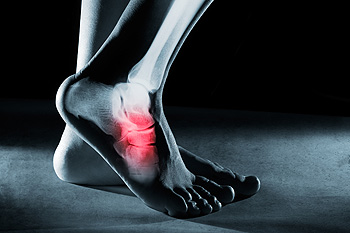What’s Causing My Lateral Foot Pain?
Tuesday, 01 December 2020 00:00 Pain felt on the outer side of the foot, or lateral foot pain, is often indicative of the condition known as cuboid syndrome. Trauma to the foot, or gradual repetitive force can cause the cuboid bone to shift out of place. Along with lateral foot pain, common symptoms of cuboid syndrome may include tenderness and swelling, difficulty walking, and pain that can worsen over time when weight is placed on the affected foot. Athletes, such as ballet dancers and runners, have been known to be affected by cuboid syndrome as their particular physical activities can put strain on the cuboid bone. For a proper diagnosis, please seek the care of a podiatrist.
Pain felt on the outer side of the foot, or lateral foot pain, is often indicative of the condition known as cuboid syndrome. Trauma to the foot, or gradual repetitive force can cause the cuboid bone to shift out of place. Along with lateral foot pain, common symptoms of cuboid syndrome may include tenderness and swelling, difficulty walking, and pain that can worsen over time when weight is placed on the affected foot. Athletes, such as ballet dancers and runners, have been known to be affected by cuboid syndrome as their particular physical activities can put strain on the cuboid bone. For a proper diagnosis, please seek the care of a podiatrist.
Cuboid syndrome, also known as cuboid subluxation, occurs when the joints and ligaments near the cuboid bone in the foot become torn. If you have cuboid syndrome, consult with one of our podiatrists from Accent Podiatry Associates. Our doctors will assess your condition and provide you with quality foot and ankle treatment.
Cuboid syndrome is a common cause of lateral foot pain, which is pain on the outside of the foot. The condition may happen suddenly due to an ankle sprain, or it may develop slowly overtime from repetitive tension through the bone and surrounding structures.
Causes
The most common causes of cuboid syndrome include:
- Injury – The most common cause of this ailment is an ankle sprain.
- Repetitive Strain – Tension placed through the peroneus longus muscle from repetitive activities such as jumping and running may cause excessive traction on the bone causing it to sublux.
- Altered Foot Biomechanics – Most people suffering from cuboid subluxation have flat feet.
Symptoms
A common symptom of cuboid syndrome is pain along the outside of the foot which can be felt in the ankle and toes. This pain may create walking difficulties and may cause those with the condition to walk with a limp.
Diagnosis
Diagnosis of cuboid syndrome is often difficult, and it is often misdiagnosed. X-rays, MRIs and CT scans often fail to properly show the cuboid subluxation. Although there isn’t a specific test used to diagnose cuboid syndrome, your podiatrist will usually check if pain is felt while pressing firmly on the cuboid bone of your foot.
Treatment
Just as the range of causes varies widely, so do treatments. Some more common treatments are ice therapy, rest, exercise, taping, and orthotics.
If you have any questions, please feel free to contact our offices located in Arlington and Mansfield, TX . We offer the newest diagnostic and treatment technologies for all your foot care needs.




